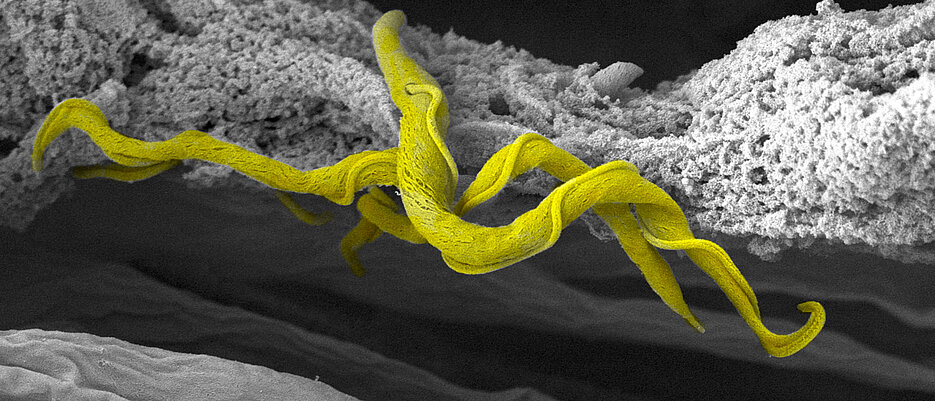The physics of parasites
05/28/2020Using a new approach, scientists are applying the techniques of physics to investigate the relationships between parasites and their hosts. The programme is led by the Würzburg cell biologist Markus Engstler.

When the animals of the Serengeti migrate to their waterholes at dusk, predatory insects are already waiting for them there. One of these, the tsetse fly, is not fussy and sucks blood from almost all the animals at the waterhole - crocodiles, zebras, lions, or buffalo. With a kind of flexible sawtoothed rapier it pierces even the most robust skin, and can inject microscopic parasites - trypanosomes - into the wound during its bloodmeal.
These unicellular organisms are accomplished microswimmers and move freely in the host's bloodstream. They can also leave the blood and swim between the cells of the skin or adipose tissue. Trypanosomes can even cross the blood-brain barrier and multiply in the brain fluid. How they manage this is unknown.
Complex journey through the fly
But the infection process is a two-way street. If an uninfected tsetse fly bites an already infected animal, the parasites will be taken up with the bloodmeal. They will then begin a new life cycle lasting several weeks in a completely different environment: the digestive tract of the blood-sucking insect. There the trypanosomes are exposed to extreme pressure and the movements of the intestine. They have to swim through extremely complex and cramped labyrinths within the fly's tissues to finally reach the salivary gland again. Every single change in the microenvironment is mirrored by an adaptation in the shape of the parasites.
And when the tsetse fly chooses a human or a farm animal for its bloodmeal, the trypanosomes become killers. Trypanosomiasis, also known as sleeping sickness, is fatal for humans and cattle when untreated.
Parasites such as trypanosomes are the focus of a new priority programme that the German Research Foundation (DFG) has now established, and which is scheduled to start work in 2021. The coordinator of the "Physics of Parasitism" programme is Professor Markus Engstler, holder of the Chair of Zoology I (Cell and Developmental Biology) at the Julius Maximilian University of Würzburg (JMU).
Start of a new research direction
"Physics of Parasitism"? Shouldn't it be "Biology of Parasitism"? "The answer is no, because the Priority Programme wants to open up a new frontier in research. The focus is actually on the physics of the parasites in their hosts," explains Markus Engstler. For example, the scientists involved in the programme want to measure and understand the physical conditions and the mechanical forces that act wherever there is contact between the parasite and its host.
They will also investigate the "material properties" of parasites, clarify the physical principles of their locomotion, and calculate the mechanical basis of their attachment to host structures. To achieve this goal, the priority programme uniquely combines expertise from parasitology, cell biology, experimental physics, and theoretical physics.
Adaptations of great optimality
This new approach is based on the observation that the behaviour of parasites is decisively influenced by their anatomy, the physics of their locomotion, and the mechanics of their attachment to host structures. "The co-evolution of parasites with their hosts has led to adaptations of great sophistication," explains Markus Engstler. Examples include parasitic tools such as microscopic suction cups and shields, or sophisticated locomotor systems that allow navigation in various body fluids as well as in confined spaces and highly viscous environments.
According to the participants, the priority programme "Physics of Parasitism" will not only open new ground in parasitology, but also in physics. "We anticipate that the results of our interdisciplinary efforts will also lead to new approaches in the fight against parasites," says Engstler. The researchers have high hopes for this direction. After all, parasites will hardly be able to develop resistance to an attack on their mechanobiology - in contrast to chemical agents.
Focus on numerous parasites
The programme combines physics, mechanics, and simulation sciences with molecular biology and parasitology. "We want to combine the enormous progress in the fields of physical measurement technology and mathematical modelling with new methods of genome manipulation and quantitative imaging in order to open a new chapter for parasitology in Germany," says Markus Engstler.
Besides trypansomes, the scientists are also focusing on other parasites that are experimentally accessible and colonise representative host niches. These include parasitic single-celled organisms such as Plasmodium, Toxoplasma and Giardia, as well as multicellular organisms such as Fasciola and Echinococcus. These are the causative agents of diseases such as malaria, toxoplasmosis, and intestinal diseases; they can attack single organs or spread throughout the human body. These parasites are particularly widespread in underdeveloped countries. As neglected tropical diseases (NTDs), they particularly affect the poorest members of the human population, which usually have no access to adequate medical care.
Priority Programmes of the DFG
The DFG has established a total of 14 new priority programmes for 2021, across all scientific disciplines and subject areas. The new consortia will receive a total of approximately 85 million euros for an initial period of three years - of which 6.6 million euros will be allocated to the programme "Physics of Parasitism".
In the coming months, the consortia will be advertised individually by the DFG, which will then review the incoming funding proposals for their scientific quality and their contribution to the respective main topic.
Contact
Prof. Dr. Markus Engstler, Chair of Zoology I - Cell and Developmental Biology, T: +49 931 31-80060, markus.engstler@biozentrum.uni-wuerzburg.de









